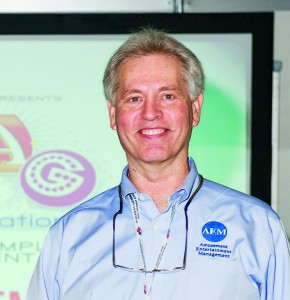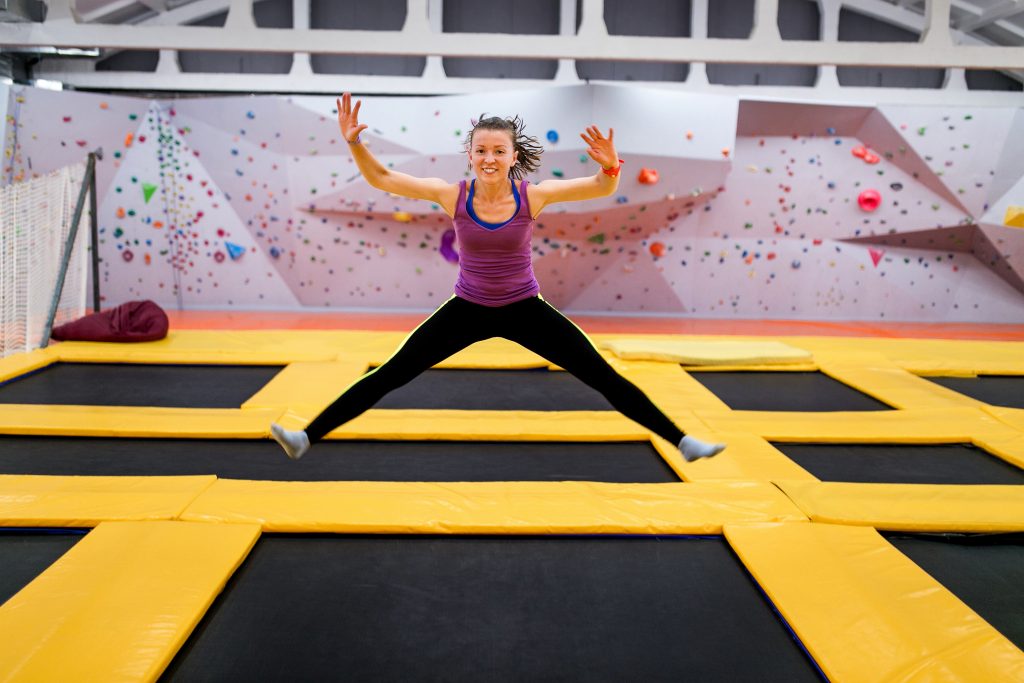What’s Hot…And What’s Not – Part Two
Trends Shaping the Amusement Industry: A look at Trampoline Parks

by Frank Seninsky, President/CEO Amusement Entertainment Management (AEM) & Alpha-Omega Amusements & Sales
If we want to talk about trends in the industry, we should first discuss those seven-year cycles that seem to surprise and haunt us simultaneously. Those mangy cycles usually have to do with a new technology and how long that technology takes to gain traction (approach utilization of 20% of the market) and increase market share.
The newest format of indoor Trampoline Parks has been developing through its cycle for more than 15 years. I first saw a prototype concept back around 2000 while traveling around the world as AMOA president. Back in the 1970s, there were outdoor trampoline pads (rectangular) and then they sort of disappeared. However, here is the official history of our modern trampoline parks:
The history of trampolines according to ActivityQuest.com: “Sky Zone indoor concept was started by Rick Platt. He obtained $2.5 million in funding and opened first test facility in 2002. The concept didn’t really take off at first, but some local skater kids started coming and in 2004, he and son Jeff opened Sky Mania; in 2006, they opened the second Sky Zone.”
Cycles: We go 2002, 2009, 2016 as seven-year marks; or you could look at it as 2004, 2011 and 2018.
IATP, the International Association of Trampoline Parks, was founded in 2012. The fact that there was a desire to form a group to support this niche business tells you that there were enough people out there who had the idea that these indoor parks make money. Jeff Blatt was elected as president, rightfully so.
Early on, they all seemed to have the same elements: basic rectangular trampolines, two to four dodge ball courts, basketball jump/dunk areas and foam pits. I’ve seen the financials for many of them and they started out really strong. It was impressive. Indoor trampoline parks that were 20,000 to 30,000 square feet were making $2 to $2.5 million gross per year.
Then as the years progressed, owners and operators started to make subtle changes, evolving their business model. First, they’d take out activities like the dodge ball courts because they took up too much space. They’d also add new attractions such as jousting on a plank over a foam pit (just like Robin Hood and Friar Tuck days), ninja warrior challenge courses, and climbing walls.
You’d think making changes would have at least kept earnings stable, but it seemed revenues started going flat or in some cases down each year. This was mainly due to individual market saturation and other competition from FECs and/or many newcomers not having conducted an independent feasibility study. One main reason for a failure is “paying too much rent” to be in a great location. Sometimes it makes more sense to pay less rent and market your business as a destination location and give more bang for the buck.
Let’s be fair here: Whenever you use an average or you look at a trend, you have to also look at the outside factors that caused this. It wasn’t that the trampoline park industry itself was flat-lining, it was because of saturation and the original business model.
I saw many cities where two, three, four and five parks (more than a dozen in a few cities) from different franchisors were just thrown into the market, and they got saturated really fast. That’s clearly one of the reasons that some of the revenue got cannibalized. During that period of time, franchisors and independent trampoline park owners didn’t pay a lot of attention to food, FEC attractions and games. The mantra had been: Open as many trampoline parks as you can, as fast as you can.
Today, we’re reaching the near end of the original seven-year cycle and there are approximately 600 trampoline parks in the United States and 400 outside of the U.S. My estimate is that half of those 400 are in the U.K.
AEM has studied the trampoline industry, completed several feasibility studies and concluded that the U.S. market probably can absorb another 400 trampoline parks over the next five years. That will bring the total to a thousand. (Of course, that’s just a projection, so yell at me if I’m wrong.) Yet the global market is “huge” and there’s truly a world of opportunity!
Today, the cost of trampoline systems has gone down, and the products are better made, safer and have more modular interchangeable activities. There’s still a great growth range for the original model in foreign markets, but, without making changes to the current model, I think the industry as a whole will suffer in the same ways that FECs suffered throughout our last 28 years, the four seven-year cycles that I can remember.
FECs got to the point where we had several thousand of them in the U.S. by 2010. Some people think we basically went up to as many as 8,000 or 9,000 at one time, though that’s counting all the bounce houses (there were a couple thousand of them). There were years when we saw 25 percent of the FEC industry failing and closing. But remember, the industry was still increasing in size which means we also were seeing another 25-30 percent of new centers come in. These were in effect “upgraded models.”
I think the trampoline park industry is going to see the same thing happen. They’ll start to see failure rates, but great success for those that are raising the bar and capturing money with extended patron visits due to the addition of food/beverage, “FEC attractions” and redemption games. This will include an influx of people new to the industry as well. We’ll see more locations become these hyphenated descriptions: trampoline-anchored FEC, FEC-anchored trampoline park, and so on.
The idea for that is to get physically bigger with more square footage, but also to keep the people there longer and increase repeat visitation. Today’s current trampoline park model plans on the average customer staying on site for an hour and a half. We see that morphing to the standard two-and-a-half hour model the FEC industry has been using for the last 30-40 years. But to do that, you must add other activities to keep people on site. That’s where food, games and other attractions come in.
The more successful trampoline parks are morphing now into a much broader financial model. There’s nothing surprising here. It’s the same thing that happened in bowling and laser tag. None of these sole attraction centers can stand alone.
When I first got into the trampoline park industry six years ago, a few franchisors told me that the kids jump for an hour and then physically they’re not hungry, they’re just thirsty, so they can have a bottle of water, Gatorade or something. So, they started adding drink vending, but still insisted the jumpers weren’t hungry and certainly didn’t need to wind down and waste time by playing games. What they were thinking is that that group of jumpers needed to get out of there so the next volume of kids could come in.
I listened to and thought, “My world runs around a stopwatch, so what I’ll do is go into these centers and time how many minutes kids jump per hour, or per visit.” What I found was that the most active kids actually jumped for only 20 minutes over their hour and a half schedule. The rest of the time, they were standing in one spot or waiting in line for the next attraction.
Some decided they were done for the visit, took their socks off and put their shoes on. And their parents couldn’t wait to get out of there because there was nothing for them to do either. Guess what the family did next? They left the trampoline park, walked down the street and went to a fast food restaurant or got into their car and drove to the closest FEC where they got some pizza, hot dogs or hamburgers and some drinks, and played games.
In some cases, the local FEC staff was out in the trampoline park parking lot handing out fliers telling them exactly where to go for the rest of their hour out-of-home trip and where they could spend another $5-$10 per capita that was burning a hole in the parents’ pockets (that the trampoline park failed to capture).
The additional revenue that 100,000 jumpers (and their parents) can bring in from spending on food and games during an extended hour could easily amount to $500,000-$750,000 per year! This has certainly been learned by the bowling industry and it won’t take long for this to gain traction in the trampoline park industry. It could be the start of a new seven-year cycle!
Frank Seninsky is president of the Alpha-Omega Group of companies, which includes a consulting agency (Amusement Entertainment Management), two nationwide revenue-sharing equipment suppliers (Alpha-Omega Amusements and Alpha-BET Entertainment), and Alpha-Omega Sales, a full-line game and related equipment distributor. During his 47 years in the leisure entertainment industry, Seninsky has presented nearly 400 seminars and continues to regularly write columns in numerous trade publications. He served as president of the AMOA (and was on the board for 22 years), and was president of IALEI (founding member and on the board for 11 years). Frank is the sole owner of Foundations Entertainment University, now in its 16th year. He is also considered a leading industry expert in the design, layout, and operations of coin-/debit card-operated arcades and FEC attractions, and is often called upon as an expert witness in cases involving the amusement industry. Frank edits The Redemption & FEC Report e-newsletter (35,000+ readers worldwide) and also writes a blog at www. frank-thecrank.com. Frank can be reached by phone at 732- 616-5345 or by email at [email protected] (website: www.AEMLLC.com).


1 Comment
Pingback: What’s Hot…And What’s Not –– Part Two - Frank 'the Crank' Seninsky Blog